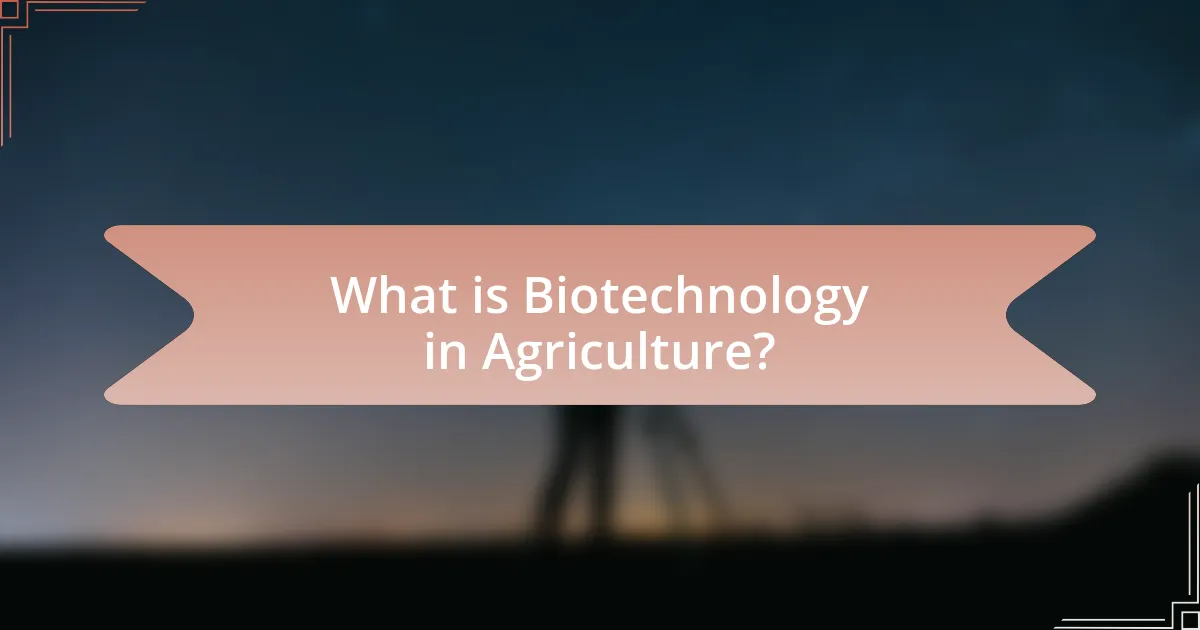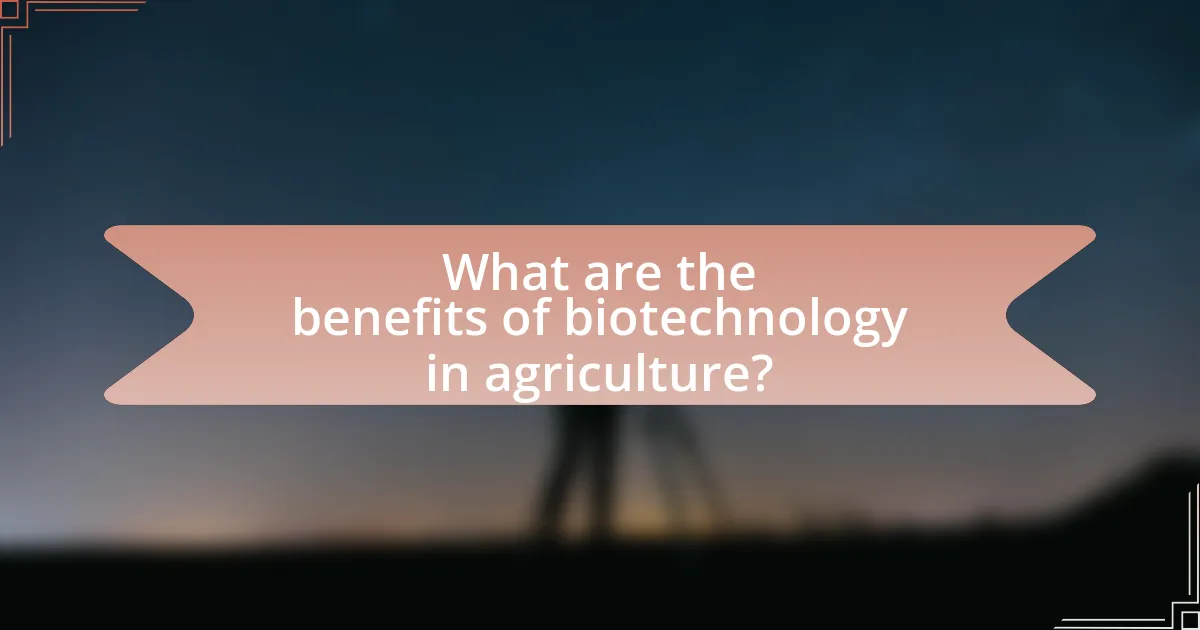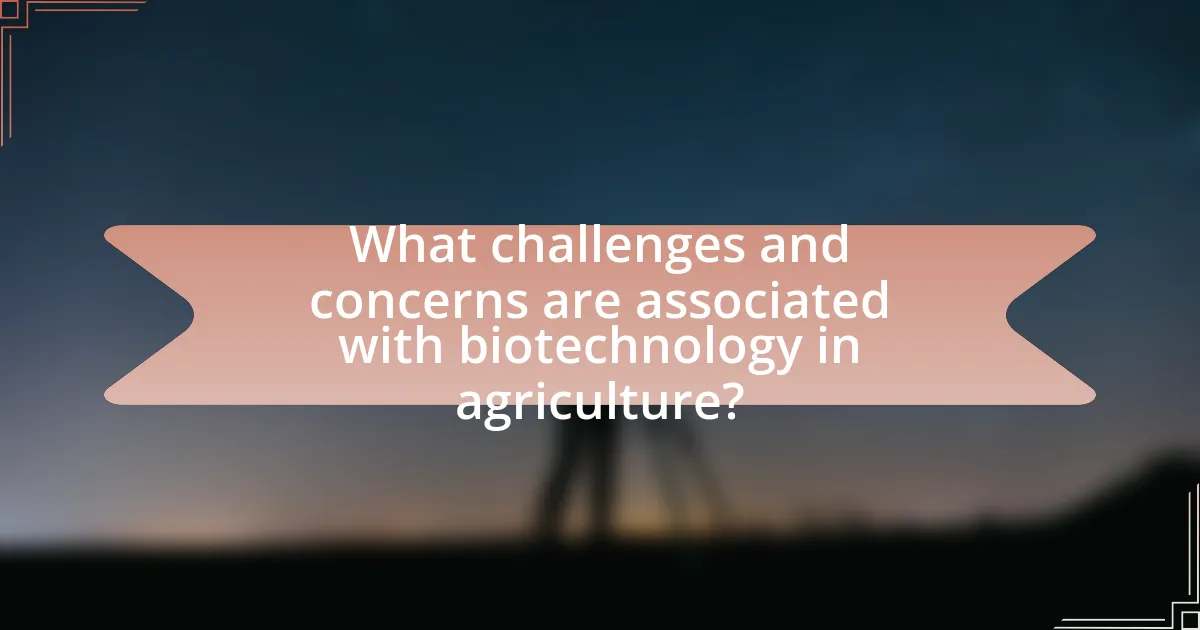Biotechnology in agriculture encompasses the application of scientific tools and techniques, such as genetic engineering and molecular markers, to enhance the traits of crops and livestock. This article explores how biotechnology differs from traditional agricultural practices, highlighting key technologies and their applications, including genetically modified organisms (GMOs), biopesticides, and biofertilizers. It discusses the benefits of biotechnology, such as increased crop yields, improved pest resistance, and enhanced nutritional content, while also addressing environmental impacts, regulatory challenges, and ethical considerations. Furthermore, the article examines future trends in biotechnology and its potential role in sustainable farming and climate change adaptation.

What is Biotechnology in Agriculture?
Biotechnology in agriculture refers to the use of scientific tools and techniques, including genetic engineering, molecular markers, and tissue culture, to modify plants and animals for agricultural purposes. This approach enables the development of crops with desirable traits such as increased resistance to pests, enhanced nutritional content, and improved tolerance to environmental stresses. For instance, genetically modified organisms (GMOs) like Bt cotton and Roundup Ready soybeans have been widely adopted, demonstrating significant yield increases and reduced pesticide use, which supports the efficiency and sustainability of agricultural practices.
How does biotechnology differ from traditional agricultural practices?
Biotechnology differs from traditional agricultural practices primarily through its use of genetic engineering to enhance crop traits. While traditional agriculture relies on selective breeding and natural processes to improve plants, biotechnology allows for precise modifications at the genetic level, enabling the introduction of specific traits such as pest resistance or drought tolerance. For instance, genetically modified organisms (GMOs) can be developed to express traits that would be difficult or impossible to achieve through conventional breeding methods, such as the Bt corn that produces its own insecticide. This precision in biotechnology leads to increased efficiency and productivity in agriculture, as evidenced by the significant yield improvements seen in GMO crops compared to their non-GMO counterparts.
What are the key technologies involved in agricultural biotechnology?
The key technologies involved in agricultural biotechnology include genetic engineering, molecular markers, tissue culture, and bioinformatics. Genetic engineering allows for the direct manipulation of an organism’s DNA to introduce desirable traits, such as pest resistance or drought tolerance. Molecular markers facilitate the identification of specific genes associated with traits, enabling more efficient breeding programs. Tissue culture techniques enable the propagation of plants under sterile conditions, ensuring disease-free plant production. Bioinformatics supports the analysis of biological data, aiding in the understanding of genetic information and improving crop development. These technologies collectively enhance agricultural productivity and sustainability.
How do these technologies enhance crop production?
Biotechnology enhances crop production by increasing yield, improving resistance to pests and diseases, and enabling better adaptation to environmental stresses. For instance, genetically modified organisms (GMOs) can be engineered to express traits such as drought tolerance, which allows crops to thrive in less favorable conditions, thereby increasing overall productivity. According to a study published in the journal “Nature Biotechnology,” the adoption of biotech crops has led to a 22% increase in global crop yields from 1996 to 2018, demonstrating the significant impact of these technologies on agricultural output.
What are the main applications of biotechnology in agriculture?
The main applications of biotechnology in agriculture include the development of genetically modified organisms (GMOs), biopesticides, and biofertilizers. GMOs are engineered to enhance traits such as pest resistance, drought tolerance, and improved nutritional content, which can lead to increased crop yields and reduced reliance on chemical inputs. For instance, Bt cotton, which contains a gene from the bacterium Bacillus thuringiensis, has been shown to reduce pesticide use by up to 80% while increasing yields by 10-30%. Biopesticides derived from natural materials offer environmentally friendly pest control solutions, while biofertilizers improve soil health and nutrient availability, promoting sustainable agricultural practices. These applications collectively contribute to food security and environmental sustainability in agriculture.
How is genetic engineering used to improve crop traits?
Genetic engineering is used to improve crop traits by directly modifying the plant’s DNA to enhance characteristics such as yield, pest resistance, and drought tolerance. Techniques like CRISPR and transgenic methods allow scientists to insert, delete, or alter specific genes associated with desirable traits. For instance, genetically modified Bt cotton contains a gene from the bacterium Bacillus thuringiensis, which provides resistance to certain pests, leading to reduced pesticide use and increased crop yields. Additionally, research published in “Nature Biotechnology” by Zhang et al. (2019) demonstrates that genetic modifications can significantly improve stress tolerance in crops, thereby enhancing food security in changing climates.
What role do biopesticides play in sustainable agriculture?
Biopesticides play a crucial role in sustainable agriculture by providing environmentally friendly alternatives to chemical pesticides. These natural agents, derived from organisms such as bacteria, fungi, and plants, help control pests and diseases while minimizing harm to non-target species and ecosystems. For instance, the use of Bacillus thuringiensis, a bacterium that targets specific insect pests, has been shown to reduce the need for synthetic pesticides, thereby decreasing chemical residues in food and soil. Research indicates that biopesticides can enhance biodiversity and promote soil health, contributing to the overall sustainability of agricultural practices.

What are the benefits of biotechnology in agriculture?
Biotechnology in agriculture offers several benefits, including increased crop yields, enhanced resistance to pests and diseases, and improved nutritional content. These advancements result from genetic modifications that allow crops to thrive in various environmental conditions and reduce reliance on chemical pesticides. For instance, genetically modified organisms (GMOs) like Bt cotton and Bt corn produce their own insecticides, leading to a significant reduction in pesticide use, which has been documented to decrease by up to 50% in some cases. Additionally, biotechnology enables the development of crops with higher nutritional value, such as Golden Rice, which is enriched with vitamin A to combat malnutrition in developing countries. These benefits contribute to sustainable agricultural practices and food security globally.
How does biotechnology contribute to food security?
Biotechnology contributes to food security by enhancing crop yields, improving resistance to pests and diseases, and enabling the development of crops that can thrive in adverse environmental conditions. For instance, genetically modified organisms (GMOs) such as Bt cotton and Bt corn have been engineered to express proteins that are toxic to specific pests, resulting in reduced pesticide use and increased crop productivity. According to the International Service for the Acquisition of Agri-biotech Applications (ISAAA), the adoption of biotech crops has led to a 22% increase in global crop yields from 1996 to 2019, significantly contributing to food availability. Additionally, biotechnology facilitates the development of biofortified crops, such as Golden Rice, which is enriched with vitamin A to combat malnutrition in regions where rice is a staple food. These advancements demonstrate that biotechnology plays a crucial role in ensuring a stable and sufficient food supply.
What impact does biotechnology have on crop yield and quality?
Biotechnology significantly enhances crop yield and quality by enabling the development of genetically modified organisms (GMOs) that are resistant to pests, diseases, and environmental stresses. For instance, crops like Bt cotton and Bt corn have been engineered to express a bacterial protein that protects them from specific insect pests, resulting in increased yields of up to 20% compared to non-GMO varieties. Additionally, biotechnology allows for the fortification of crops with essential nutrients, improving their nutritional quality; an example is Golden Rice, which has been enriched with vitamin A to combat deficiencies in populations reliant on rice as a staple food. These advancements demonstrate that biotechnology plays a crucial role in increasing agricultural productivity and enhancing the nutritional value of food crops.
How does biotechnology help in pest and disease management?
Biotechnology aids in pest and disease management by developing genetically modified organisms (GMOs) that are resistant to specific pests and pathogens. These GMOs can express traits such as insect resistance or disease tolerance, significantly reducing the need for chemical pesticides. For instance, Bt cotton and Bt corn are engineered to produce a protein from the bacterium Bacillus thuringiensis, which is toxic to certain insects, thereby minimizing crop damage and enhancing yield. Research has shown that the adoption of Bt crops has led to a 37% reduction in pesticide use and increased profits for farmers, demonstrating the effectiveness of biotechnology in sustainable agricultural practices.
What environmental benefits does biotechnology offer?
Biotechnology offers significant environmental benefits, including reduced pesticide use, enhanced soil health, and improved crop resilience. By developing genetically modified organisms (GMOs) that are resistant to pests and diseases, biotechnology decreases the reliance on chemical pesticides, which can harm non-target species and contaminate water sources. For instance, Bt cotton and Bt corn produce their own insecticides, leading to a 37% reduction in pesticide use in some regions. Additionally, biotechnology can enhance soil health through the development of crops that require fewer inputs, thereby reducing soil degradation and erosion. Furthermore, biotech crops can be engineered to withstand extreme weather conditions, such as drought or flooding, which helps maintain agricultural productivity and reduces the need for irrigation, conserving water resources. These advancements demonstrate how biotechnology can contribute to more sustainable agricultural practices and environmental conservation.
How does biotechnology reduce the need for chemical fertilizers and pesticides?
Biotechnology reduces the need for chemical fertilizers and pesticides by developing genetically modified crops that are more resilient to pests and nutrient-efficient. These crops can produce higher yields with less input, as they are engineered to utilize soil nutrients more effectively and to resist pest infestations naturally. For instance, Bt cotton and Bt corn are genetically modified to express a protein from the bacterium Bacillus thuringiensis, which provides built-in pest resistance, significantly decreasing the reliance on chemical insecticides. Studies have shown that the adoption of such biotechnological advancements can lead to a reduction in chemical pesticide use by up to 50%, thereby promoting more sustainable agricultural practices.
What are the implications of biotechnology for biodiversity?
Biotechnology has significant implications for biodiversity, primarily through its ability to enhance agricultural productivity while potentially reducing the genetic diversity of crops. The introduction of genetically modified organisms (GMOs) can lead to increased yields and resistance to pests and diseases, which may help in conserving natural habitats by reducing the need for land conversion. However, the widespread use of a limited number of genetically engineered crops can diminish the genetic variability essential for ecosystem resilience. Studies indicate that monoculture practices associated with biotechnology can lead to a decline in native species and disrupt local ecosystems, as seen in regions where GM crops dominate. Thus, while biotechnology can improve agricultural efficiency, it poses risks to biodiversity that must be carefully managed.

What challenges and concerns are associated with biotechnology in agriculture?
Biotechnology in agriculture faces several challenges and concerns, including environmental risks, health implications, and socio-economic issues. Environmental risks involve potential harm to non-target species and the development of resistant pests and weeds due to genetically modified organisms (GMOs). Health implications raise concerns about allergenicity and long-term effects of consuming GMO products, as highlighted by studies indicating potential links to health issues. Socio-economic issues include the monopolization of seed markets by a few large corporations, which can lead to reduced biodiversity and increased costs for farmers. These challenges necessitate careful regulation and ongoing research to ensure the safe and equitable use of biotechnology in agriculture.
What are the ethical considerations surrounding genetically modified organisms (GMOs)?
The ethical considerations surrounding genetically modified organisms (GMOs) include concerns about environmental impact, food safety, and socio-economic effects. Environmental impact raises questions about biodiversity loss and the potential for GMOs to crossbreed with wild species, which could disrupt ecosystems. Food safety concerns focus on the long-term health effects of consuming GMOs, with studies indicating that while GMOs are generally considered safe, some groups advocate for more rigorous testing. Socio-economic effects involve issues of corporate control over seeds, which can lead to increased dependency of farmers on biotech companies and potential loss of traditional farming practices. These considerations highlight the need for careful regulation and public dialogue regarding the use of GMOs in agriculture.
How do public perceptions of biotechnology affect its adoption?
Public perceptions of biotechnology significantly influence its adoption in agriculture. Positive perceptions, characterized by trust in scientific advancements and awareness of benefits, lead to increased acceptance and implementation of biotechnological innovations. For instance, a survey by the Pew Research Center in 2015 indicated that 88% of scientists believe genetically modified organisms (GMOs) are safe to eat, yet public skepticism remains high, with only 37% of the general public agreeing. This disparity highlights how negative perceptions can hinder the adoption of biotechnology, as consumers may resist products perceived as unnatural or risky. Furthermore, misinformation and lack of understanding about biotechnology can exacerbate fears, leading to regulatory challenges and market resistance. Thus, fostering a better public understanding of biotechnology is crucial for its successful integration into agricultural practices.
What regulatory challenges do biotechnological innovations face?
Biotechnological innovations face significant regulatory challenges primarily related to safety assessments, environmental impact evaluations, and public acceptance. Regulatory bodies, such as the U.S. Environmental Protection Agency and the European Food Safety Authority, require extensive data on the potential risks of genetically modified organisms (GMOs) before approval, which can delay the introduction of new technologies. For instance, the European Union has stringent regulations that mandate comprehensive risk assessments, leading to lengthy approval processes that can take years. Additionally, public skepticism regarding GMOs often influences regulatory frameworks, as seen in various countries where consumer concerns have led to stricter labeling requirements and bans on certain biotechnological products. These challenges hinder the rapid deployment of innovations that could enhance agricultural productivity and sustainability.
How can the risks of biotechnology be managed?
The risks of biotechnology can be managed through comprehensive regulatory frameworks, risk assessment protocols, and public engagement strategies. Regulatory frameworks, such as those established by the U.S. Environmental Protection Agency and the European Food Safety Authority, ensure that biotechnological products undergo rigorous safety evaluations before approval. Risk assessment protocols involve identifying potential hazards, evaluating exposure levels, and assessing the consequences of biotechnological applications, which helps in making informed decisions. Public engagement strategies, including transparent communication and stakeholder involvement, foster trust and understanding among communities affected by biotechnological advancements. These combined approaches have been shown to effectively mitigate risks associated with biotechnology in agriculture, as evidenced by the successful implementation of genetically modified organisms (GMOs) that have undergone extensive safety assessments and monitoring.
What best practices should be followed in the development of biotechnological crops?
Best practices in the development of biotechnological crops include rigorous risk assessment, stakeholder engagement, and adherence to regulatory frameworks. Rigorous risk assessment ensures that potential environmental and health impacts are evaluated before crop release, as demonstrated by the U.S. National Academy of Sciences, which emphasizes the importance of thorough testing for safety and efficacy. Stakeholder engagement involves collaboration with farmers, consumers, and scientists to address concerns and improve acceptance, as highlighted in studies showing that transparent communication increases public trust in biotechnological advancements. Adherence to regulatory frameworks, such as those established by the Environmental Protection Agency and the Food and Drug Administration, ensures compliance with safety standards and promotes responsible innovation in crop development.
How can stakeholders ensure the safe use of biotechnology in agriculture?
Stakeholders can ensure the safe use of biotechnology in agriculture by implementing rigorous regulatory frameworks and conducting thorough risk assessments. Regulatory bodies, such as the U.S. Environmental Protection Agency and the European Food Safety Authority, establish guidelines that require extensive testing of genetically modified organisms (GMOs) for environmental and health impacts before approval. Additionally, stakeholders can engage in transparent communication with the public to address concerns and provide education on the benefits and risks associated with biotechnology. Research indicates that countries with strong regulatory systems, like Canada, have successfully managed the introduction of biotech crops while maintaining public trust and safety.
What are the future trends in biotechnology for agriculture?
Future trends in biotechnology for agriculture include the development of CRISPR gene editing, which allows for precise modifications to crop genomes, enhancing traits such as drought resistance and pest tolerance. Additionally, advancements in synthetic biology are enabling the creation of bio-based fertilizers and pesticides that are more environmentally friendly. The integration of artificial intelligence with biotechnology is also expected to optimize crop management and yield prediction. According to a report by the Food and Agriculture Organization, these innovations could significantly increase agricultural productivity while reducing environmental impact, addressing the challenges of food security and climate change.
How might advancements in biotechnology shape sustainable farming practices?
Advancements in biotechnology can significantly shape sustainable farming practices by enhancing crop resilience and reducing the need for chemical inputs. For instance, genetically modified organisms (GMOs) can be engineered to withstand pests, diseases, and environmental stresses, leading to higher yields and less reliance on pesticides. According to a study published in the journal “Nature,” crops engineered for pest resistance have shown a 37% reduction in pesticide use, which directly contributes to environmental sustainability. Additionally, biotechnology can facilitate the development of crops that require less water and nutrients, optimizing resource use and minimizing agricultural runoff. This integration of biotechnology into farming practices not only promotes sustainability but also supports food security in the face of climate change challenges.
What role will biotechnology play in addressing climate change impacts on agriculture?
Biotechnology will play a crucial role in addressing climate change impacts on agriculture by enhancing crop resilience to environmental stressors. Through genetic modification and advanced breeding techniques, biotechnology enables the development of crop varieties that can withstand extreme weather conditions, such as droughts and floods, which are becoming more frequent due to climate change. For instance, research has shown that genetically engineered crops, like drought-tolerant maize, can yield up to 20% more in water-scarce conditions compared to conventional varieties. This adaptation not only helps maintain food security but also reduces the need for chemical inputs, thereby lowering the agricultural carbon footprint.
What practical steps can farmers take to integrate biotechnology into their practices?
Farmers can integrate biotechnology into their practices by adopting genetically modified organisms (GMOs) that enhance crop yield and resistance to pests. For instance, using Bt cotton, which is engineered to produce a bacterial toxin that deters pests, has led to a 24% increase in yield in regions where it is implemented. Additionally, farmers can utilize biopesticides and biofertilizers derived from natural organisms to improve soil health and reduce chemical inputs. Research shows that the use of these biotechnological tools can lead to sustainable farming practices, as evidenced by a study published in the journal “Nature Biotechnology,” which highlights the positive impact of biotechnology on crop productivity and environmental sustainability.


